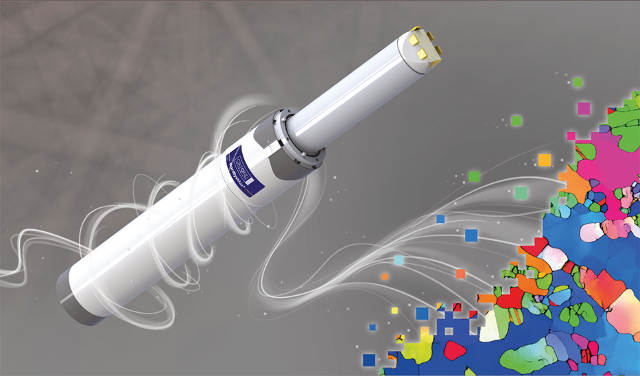Oxford Instruments, a leading supplier of microanalysis systems, has launched NordlysMax3, an EBSD detector that acquires indexes and displays results at 1580 points per second.
 Oxford Instruments’ NordlysMax3. At 1580 points per second, it is the World’s fastest commercial EBSD detector.
Oxford Instruments’ NordlysMax3. At 1580 points per second, it is the World’s fastest commercial EBSD detector.
This performance is sustained during simultaneous EBSD and EDS acquisition. This is the world’s fastest commercial EBSD system; full EBSD maps displaying sample microstructure are completed twice as fast, which can represent a saving of many hours.
According to Dr. Jenny Goulden, EBSD Business Manager:
NordlysMax3 provides the same sensitivity as our previous detector but delivers almost double the speed. It also represents a breakthrough for those performing in-situ experiments where data are collected under dynamic conditions, such as increasing strain or temperature.
- Acquire and index EBSD data in real-time at up to 1580 pps and with 99% validated hit rate
- View all indexed data as acquired
- Create and interrogate maps and line scans in real-time
- Fastest, most efficient data collection
- Collect EBSD and EDS data simultaneously at full speed
- Create EBSD and EDS maps in real-time
- Unleash the performance of the X-Max N 150 SDD for the fastest data collection
- View EBSPs and spectra from areas of interest, during or after analysis
- Nordlys Max 3 is a single choice high-speed detector for all EBSD applications
- No compromise in performance
- Operation down to 5 kV
- Operation at low probe current (100 pA)
- The ideal solution for capturing dynamic changes
- In-chamber heating or tensile experiments
- Collect more data during dynamic tests
- Integrated IR filter as standard
- All the advantages of the Nordlys design:
- Optimum geometry for combined EBSD & EDS
- Up to six forescatter diodes (FSD)
About Oxford Instruments plc
Oxford Instruments designs, supplies and supports high-technology tools and systems with a focus on research and industrial applications. Innovation has been the driving force behind Oxford Instruments' growth and success for over 50 years, and its strategy is to effect the successful commercialisation of these ideas by bringing them to market in a timely and customer-focused fashion.
The first technology business to be spun out from Oxford University, Oxford Instruments is now a global company with over 2300 staff worldwide and is listed on the FTSE250 index of the London Stock Exchange (OXIG). Its objective is to be the leading provider of new generation tools and systems for the research and industrial sectors with a focus on nanotechnology. Its key market sectors include nano-fabrication and nano-materials. The company’s strategy is to expand the business into the life sciences arena, where nanotechnology and biotechnology intersect
This involves the combination of core technologies in areas such as low temperature, high magnetic field and ultra high vacuum environments; Nuclear Magnetic Resonance; x-ray, electron, laser and optical based metrology; atomic force microscopy; optical imaging; advanced growth, deposition and etching.
Oxford Instruments aims to pursue responsible development and deeper understanding of our world through science and technology. Its products, expertise, and ideas address global issues such as energy, environment, security and health.